Exhibit 99.1

Investor Deck
August 2014
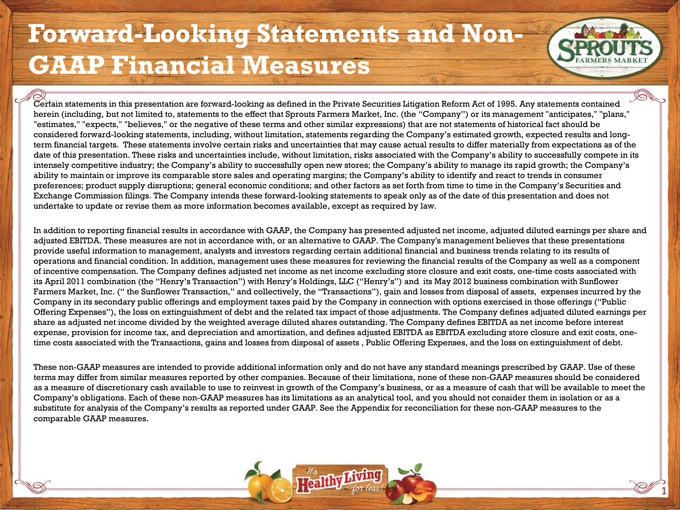
Forward-Looking Statements and Non-
GAAP Financial Measures
Certain statements in this presentation are forward-looking as defined in the Private Securities Litigation Reform Act of 1995. Any statements contained herein (including, but not limited to, statements to the effect that Sprouts Farmers Market, Inc. (the “Company”) or its management “anticipates,” “plans,” “estimates,” “expects,” “believes,” or the negative of these terms and other similar expressions) that are not statements of historical fact should be considered forward-looking statements, including, without limitation, statements regarding the Company’s estimated growth, expected results and long-term financial targets. These statements involve certain risks and uncertainties that may cause actual results to differ materially from expectations as of the date of this presentation. These risks and uncertainties include, without limitation, risks associated with the Company’s ability to successfully compete in its intensely competitive industry; the Company’s ability to successfully open new stores; the Company’s ability to manage its rapid growth; the Company’s ability to maintain or improve its comparable store sales and operating margins; the Company’s ability to identify and react to trends in consumer preferences; product supply disruptions; general economic conditions; and other factors as set forth from time to time in the Company’s Securities and Exchange Commission filings. The Company intends these forward-looking statements to speak only as of the date of this presentation and does not undertake to update or revise them as more information becomes available, except as required by law.
In addition to reporting financial results in accordance with GAAP, the Company has presented adjusted net income, adjusted diluted earnings per share and adjusted EBITDA. These measures are not in accordance with, or an alternative to GAAP. The Company’s management believes that these presentations provide useful information to management, analysts and investors regarding certain additional financial and business trends relating to its results of operations and financial condition. In addition, management uses these measures for reviewing the financial results of the Company as well as a component of incentive compensation. The Company defines adjusted net income as net income excluding store closure and exit costs, one-time costs associated with its April 2011 combination (the “Henry’s Transaction”) with Henry’s Holdings, LLC (“Henry’s”) and its May 2012 business combination with Sunflower Farmers Market, Inc. (“ the Sunflower Transaction,” and collectively, the “Transactions”), gain and losses from disposal of assets, expenses incurred by the Company in its secondary public offerings and employment taxes paid by the Company in connection with options exercised in those offerings (“Public Offering Expenses”), the loss on extinguishment of debt and the related tax impact of those adjustments. The Company defines adjusted diluted earnings per share as adjusted net income divided by the weighted average diluted shares outstanding. The Company defines EBITDA as net income before interest expense, provision for income tax, and depreciation and amortization, and defines adjusted EBITDA as EBITDA excluding store closure and exit costs, one-time costs associated with the Transactions, gains and losses from disposal of assets , Public Offering Expenses, and the loss on extinguishment of debt.
These non-GAAP measures are intended to provide additional information only and do not have any standard meanings prescribed by GAAP. Use of these terms may differ from similar measures reported by other companies. Because of their limitations, none of these non-GAAP measures should be considered as a measure of discretionary cash available to use to reinvest in growth of the Company’s business, or as a measure of cash that will be available to meet the Company’s obligations. Each of these non-GAAP measures has its limitations as an analytical tool, and you should not consider them in isolation or as a substitute for analysis of the Company’s results as reported under GAAP. See the Appendix for reconciliation for these non-GAAP measures to the comparable GAAP measures.
1
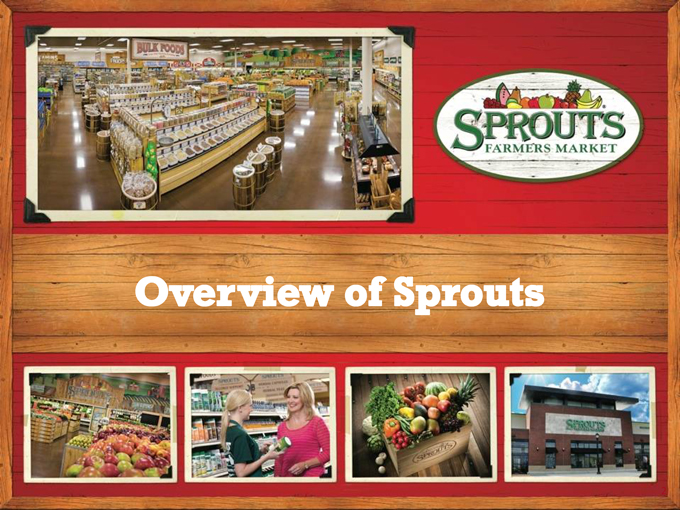
Overview of Sprouts
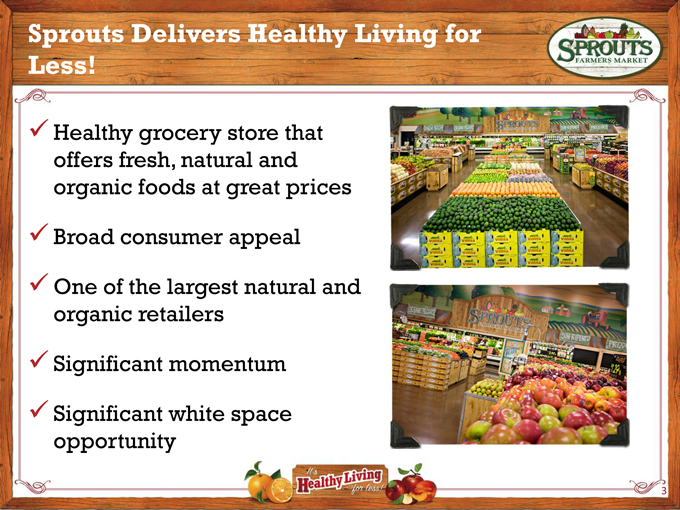
Sprouts Delivers Healthy Living for
Less!
Healthy grocery store that
offers fresh, natural and
organic foods at great prices
Broad consumer appeal
One of the largest natural and
organic retailers
Significant momentum
Significant white space
opportunity
3
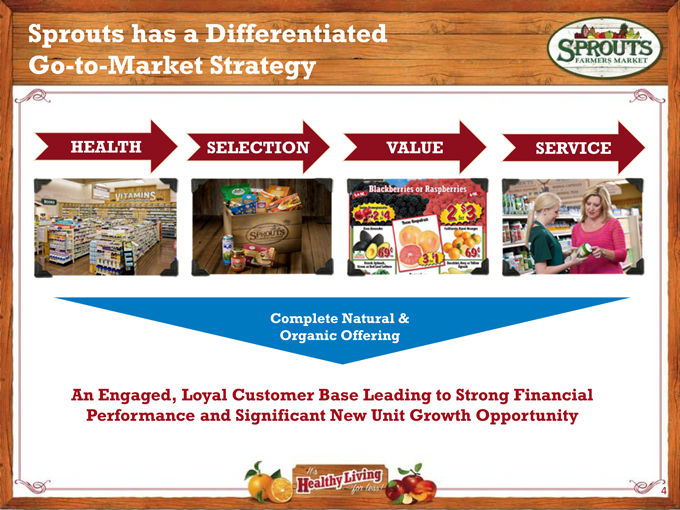
Sprouts has a Differentiated
Go-to-Market Strategy
HEALTH SELECTION VALUE SERVICE
Complete Natural &
Organic Offering
An Engaged, Loyal Customer Base Leading to Strong Financial
Performance and Significant New Unit Growth Opportunity
4
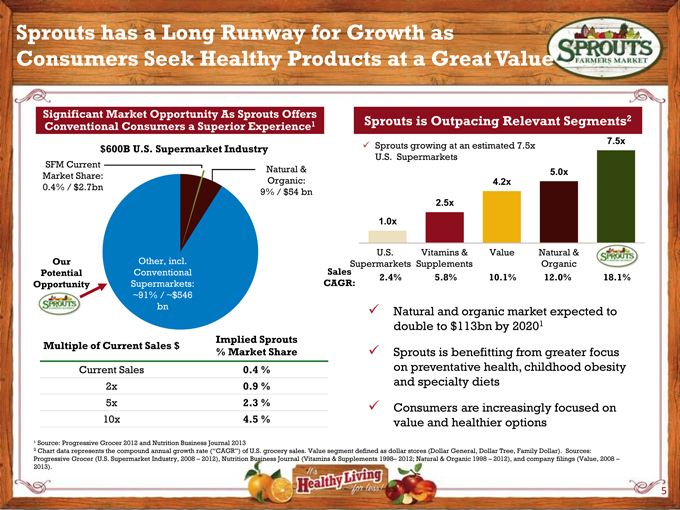
Sprouts has a Long Runway for Growth as
Consumers Seek Healthy Products at a Great Value
Significant Market Opportunity As Sprouts Offers
2
1 Sprouts is Outpacing Relevant Segments
Conventional Consumers a Superior Experience
7.5x
Sprouts growing at an estimated 7.5x
$600B U.S. Supermarket Industry
U.S. Supermarkets
SFM Current
Natural &
5.0x
Market Share:
Organic:
4.2x
0.4% / $2.7bn
9% / $54 bn
2.5x
1.0x
U.S. Vitamins & Value Natural &
Our Other, incl.
Supermarkets Supplements Organic
Sales
Potential Conventional
2.4% 5.8% 10.1% 12.0% 18.1%
CAGR:
Opportunity Supermarkets:
~91% / ~$546
bn
Natural and organic market expected to
double to $113bn by 2020 1
Implied Sprouts
Multiple of Current Sales $
% Market Share
Sprouts is benefitting from greater focus
on preventative health, childhood obesity
Current Sales 0.4 %
and specialty diets
2x 0.9 %
5x 2.3 %
Consumers are increasingly focused on
10x 4.5 %
value and healthier options
¹ Source: Progressive Grocer 2012 and Nutrition Business Journal 2013
2
Chart data represents the compound annual growth rate (“CAGR”) of U.S. grocery sales. Value segment defined as dollar stores (Dollar General, Dollar Tree, Family Dollar). Sources:
Progressive Grocer (U.S. Supermarket Industry, 2008 – 2012), Nutrition Business Journal (Vitamins & Supplements 1998– 2012; Natural & Organic 1998 – 2012), and company filings (Value, 2008 –
2013).
5
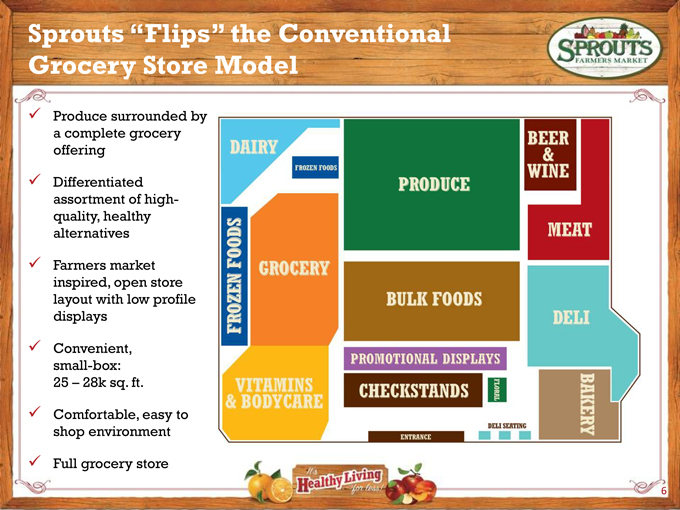
Sprouts “Flips” the Conventional
Grocery Store Model
Produce surrounded by
a complete grocery
offering
Differentiated
assortment of high-
quality, healthy
alternatives
Farmers market
inspired, open store
layout with low profile
displays
Convenient,
small-box:
25 – 28k sq. ft.
Comfortable, easy to
shop environment
Full grocery store
6
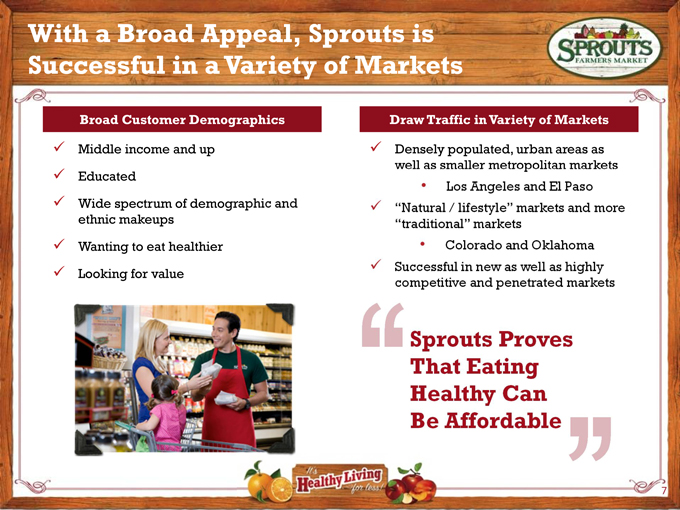
With a Broad Appeal, Sprouts is
Successful in a Variety of Markets
Broad Customer Demographics Draw Traffic in Variety of Markets
Middle income and up Densely populated, urban areas as well as smaller metropolitan markets
Los Angeles and EI Paso “Natural / lifestyle” markets and more “traditional” markets
Colorado and Oklahoma
Successful in new as well as highly competitive and penetrated markets
“Sprouts Proves That Eating Healthy Can Be Affordable”
Educated
Wide spectrum of demographic and
ethnic makeups
Wanting to eat healthier
Looking for value
7
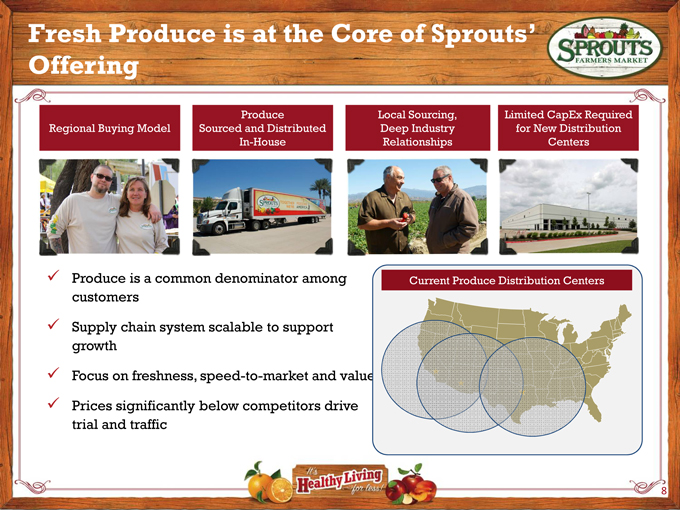
Fresh Produce is at the Core of Sprouts’
Offering
Produce Local Sourcing, Limited CapEx Required
Regional Buying Model Sourced and Distributed Deep Industry for New Distribution
In-House Relationships Centers
Produce is a common denominator among
Current Produce Distribution Centers
customers
Supply chain system scalable to support
growth
Focus on freshness, speed-to-market and value
Prices significantly below competitors drive
trial and traffic
8
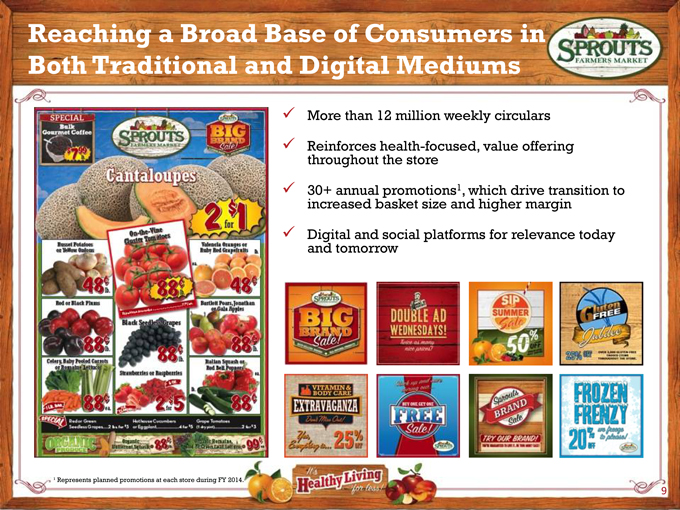
Reaching a Broad Base of Consumers in
Both Traditional and Digital Mediums
More than 12 million weekly circulars
Reinforces health-focused, value offering
throughout the store
30+ annual promotions1, which drive transition to
increased basket size and higher margin
Digital and social platforms for relevance today
and tomorrow
¹ Represents planned promotions at each store during FY 2014.
9
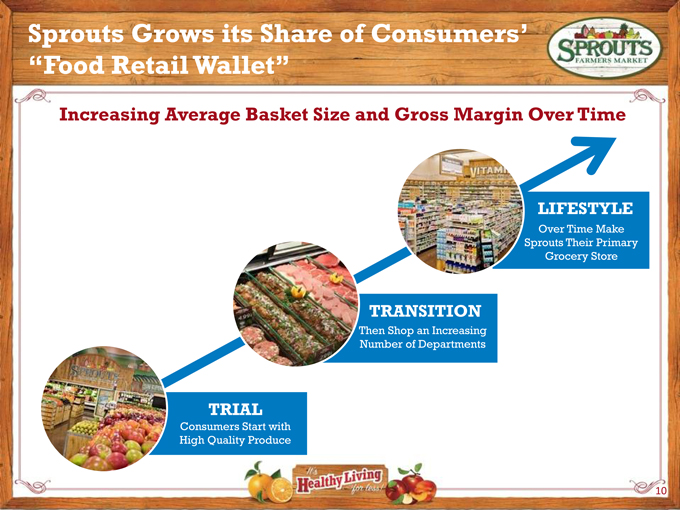
Sprouts Grows its Share of Consumers’
“Food Retail Wallet”
Increasing Average Basket Size and Gross Margin Over Time
LIFESTYLE
Over Time Make
Sprouts Their Primary
Grocery Store
TRANSITION
Then Shop an Increasing
Number of Departments
TRIAL
Consumers Start with
High Quality Produce
10

Estimated 15+ Years of New Store
Growth
Proven Concept: 182 stores in ten states as of August 7, 2014
Strong performance across all markets, demographics and real estate venues
Opened 15 new stores YTD with a target of 14% unit growth over at least the next five
years
24 new stores planned in 2014 (14% unit growth)
Demographics allow for deep penetration in markets Potential U.S. Store Count¹
~1,200
Nevada
Utah
5
Colorado
Kansas
4
25
77 1 Missouri 6.6x North
California
New Carolina Arizona Oklahoma Tennessee Arkansas
Mexico
5
27
South
Georgia
6
Carolina
182 300 in
Texas 2
Existing
30
1.6x Markets
Alabama Florida
Existing Market Louisiana
As of August 7, Potential
Mississippi
Target Near Term New Market
2014
¹ Based on an assumed new store growth rate of 14% per year and research conducted by Buxton Company in 2012.
11
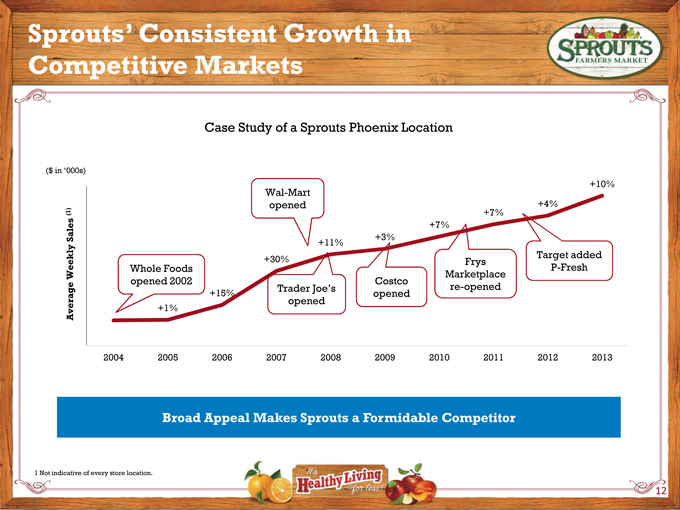
Sprouts’ Consistent Growth in
Competitive Markets
Case Study of a Sprouts Phoenix Location
($ in ‘000s)
+10%
Wal-Mart
(1) opened +4%
+7%
+7%
Sales +3% +11%
Target added
+30%
Frys
Whole Foods P-Fresh Weekly Marketplace opened 2002 Costco
re-opened Trader Joe’s
+15% opened
opened
Average +1%
2004 2005 2006 2007 2008 2009 2010 2011 2012 2013
Broad Appeal Makes Sprouts a Formidable Competitor
1 Not indicative of every store location.
12
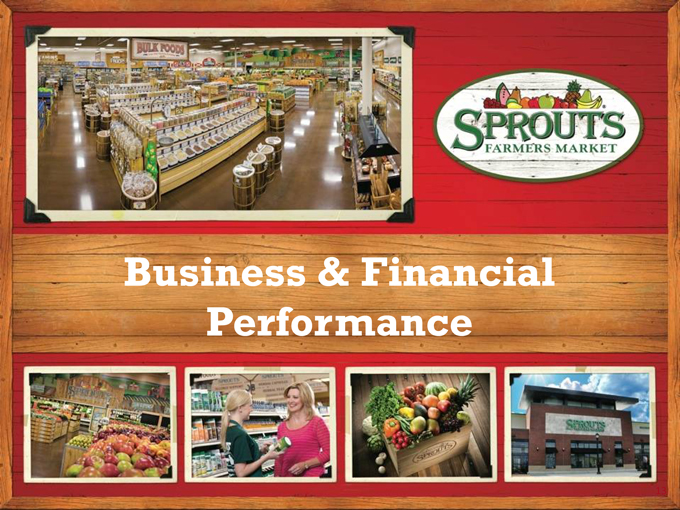
Business & Financial
Performance
13
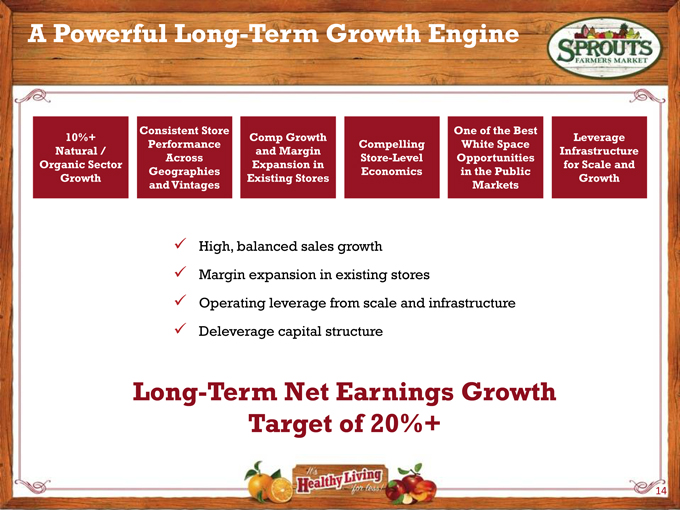
A Powerful Long-Term Growth Engine
Consistent Store One of the Best
10%+ Comp Growth Leverage
Performance Compelling White Space
Natural / and Margin Infrastructure
Across Store-Level Opportunities
Organic Sector Expansion in for Scale and
Geographies Economics in the Public
Growth Existing Stores Growth
and Vintages Markets
High, balanced sales growth
Margin expansion in existing stores
Operating leverage from scale and infrastructure
Deleverage capital structure
Long-Term Net Earnings Growth
Target of 20%+
14

History of Organic Growth
1 2
Pro Forma Net Sales Pro Forma Comparable Store Sales Growth
($ in mm)
‘08-’13 CAGR: 18.1%
20.4% $2,438
$1,991
14.8%
10.7% $1,723
$1,490 11.6%
$1,239
2.6%
9.7% $1,059
7.4%
4.9%
5.1%
2.3%
2008 2009 2010 2011 2012 2013
2009 2010 2011 2012 2013
Prior Period Current Period Two-Year Stacked
Balanced Sales Growth Across Comparable Store Sales Growth and New Store
Openings
¹ Pro forma net sales reflect the net sales of our predecessor entity, Henry’s and Sunflower as if the Transactions had been consummated on the first day of fiscal 2008.
2
“Comparable store sales growth” refers to the percentage change in our comparable store sales as compared to the prior comparable period. Pro forma comparable store sales growth is calculated including all stores acquired in the Transactions for all periods reported. Comparable store sales growth on a “two-year stacked basis” is computed by adding the pro forma comparable store sales growth of the period referenced and that of the same fiscal period ended twelve months prior.
15
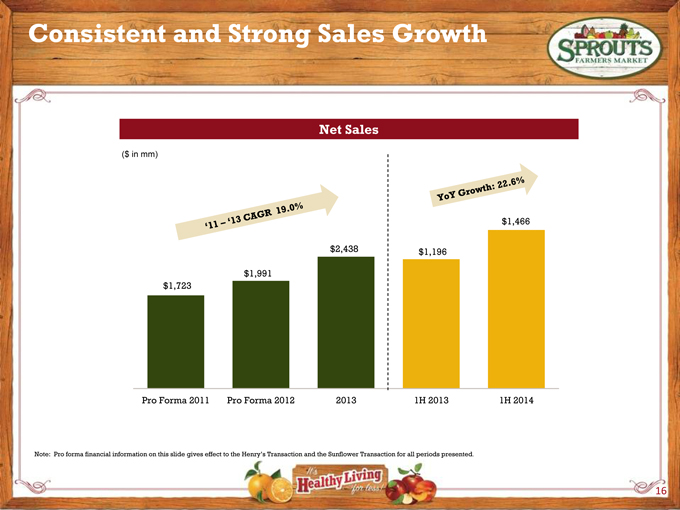
Consistent and Strong Sales Growth
Net Sales
($ in mm)
‘11-’13 CAGR 19.0% YoY Growth: 22.6%
$1,466
$2,438
$1,196
$1,991
$1,723
Pro Forma 2011 Pro Forma 2012 2013 1H 2013 1H 2014
Note: Pro forma financial information on this slide gives effect to the Henry’s Transaction and the Sunflower Transaction for all periods presented.
16
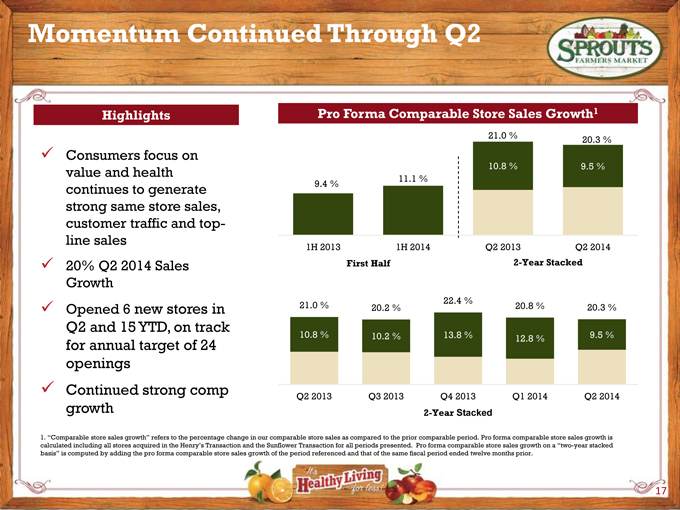
Momentum Continued Through Q2
Highlights
Consumers focus on value and health continues to generate strong same store sales, customer traffic and top-line sales
20% Q2 2014 Sales
Growth
Opened 6 new stores in Q2 and 15 YTD, on track for annual target of 24 openings
Continued strong comp
growth
1
Pro Forma Comparable Store Sales Growth
21.0 %
20.3 %
10.8 % 9.5 %
11.1 %
9.4 %
1H 2013 1H 2014 Q2 2013 Q2 2014
First Half 2-Year Stacked
22.4 %
21.0 %
20.8 % 20.3 %
20.2 %
10.8 % 10.2 % 13.8 % 9.5 %
12.8 %
Q2 2013 Q3 2013 Q4 2013 Q1 2014 Q2 2014
2-Year Stacked
1. “Comparable store sales growth” refers to the percentage change in our comparable store sales as compared to the prior comparable period. Pro forma comparable store sales growth is calculated including all stores acquired in the Henry’s Transaction and the Sunflower Transaction for all periods presented. Pro forma comparable store sales growth on a “two-year stacked basis” is computed by adding the pro forma comparable store sales growth of the period referenced and that of the same fiscal period ended twelve months prior.
17
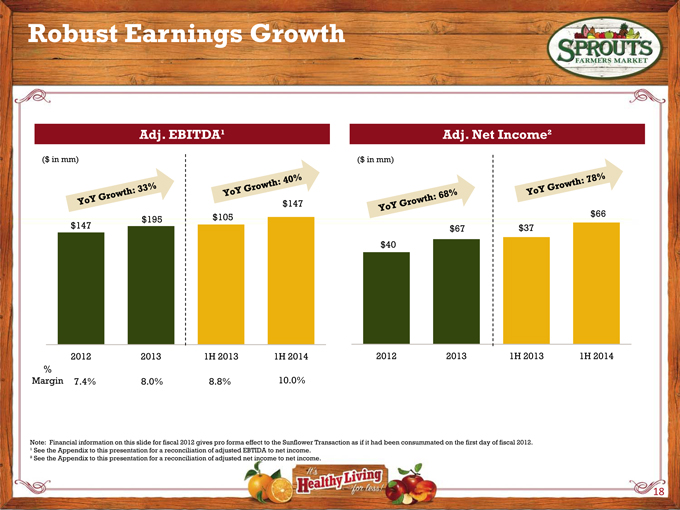
Robust Earnings Growth
Adj. EBITDA¹ Adj. Net Income²
($ in mm) ($ in mm)
YoY Growth: 33% YoY Growth: 40% YoY Growth: 68% YoY Growth: 78%
$147
$66
$105 $195
$147 $37 $67
$40
2012 2013 1H 2013 1H 2014 2012 2013 1H 2013 1H 2014
%
Margin 10.0%
7.4% 8.0% 8.8%
Note: Financial information on this slide for fiscal 2012 gives pro forma effect to the Sunflower Transaction as if it had been consummated on the first day of fiscal 2012.
¹ See the Appendix to this presentation for a reconciliation of adjusted EBTIDA to net income.
² See the Appendix to this presentation for a reconciliation of adjusted net income to net income.
18
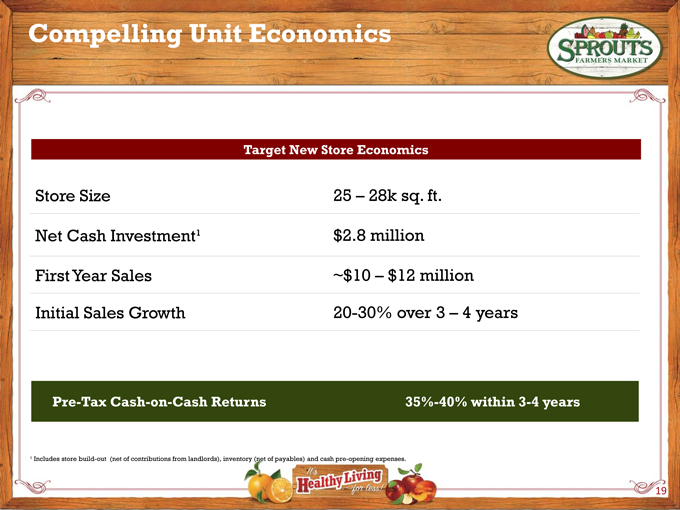
Compelling Unit Economics
Target New Store Economics
Store Size 25 – 28k sq. ft.
Net Cash Investment¹ $2.8 million
First Year Sales ~$10 – $12 million
Initial Sales Growth 20-30% over 3 – 4 years
Pre-Tax Cash-on-Cash Returns
35%-40% within 3-4 years
¹ Includes store build-out (net of contributions from landlords), inventory (net of payables) and cash pre-opening expenses.
19
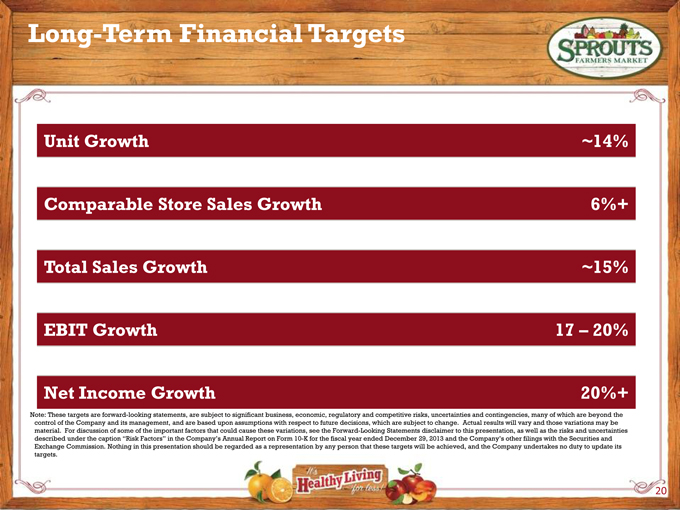
Long-Term Financial Targets
Unit Growth
~14%
Comparable Store Sales Growth 6%+
Total Sales Growth ~15%
EBIT Growth 17 – 20%
Net Income Growth
20%+
Note: These targets are forward-looking statements, are subject to significant business, economic, regulatory and competitive risks, uncertainties and contingencies, many of which are beyond the control of the Company and its management, and are based upon assumptions with respect to future decisions, which are subject to change. Actual results will vary and those variations may be material. For discussion of some of the important factors that could cause these variations, see the Forward-Looking Statements disclaimer to this presentation, as well as the risks and uncertainties described under the caption “Risk Factors” in the Company’s Annual Report on Form 10-K for the fiscal year ended December 29, 2013 and the Company’s other filings with the Securities and Exchange Commission. Nothing in this presentation should be regarded as a representation by any person that these targets will be achieved, and the Company undertakes no duty to update its targets.
20
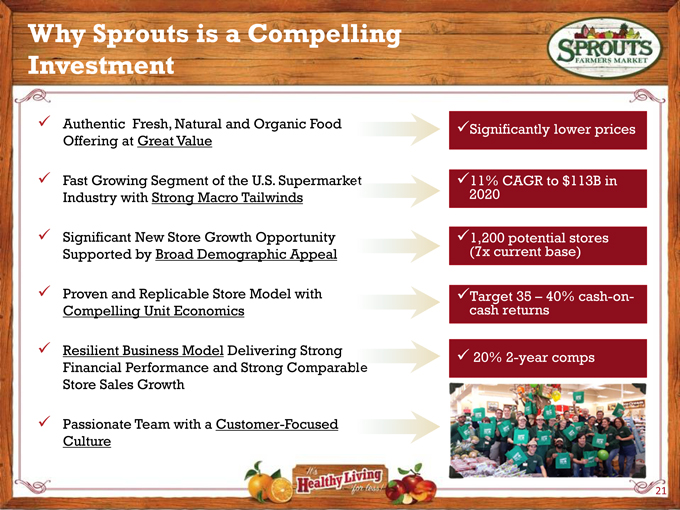
Why Sprouts is a Compelling
Investment
Authentic Fresh, Natural and Organic Food
Offering at Great Value
Fast Growing Segment of the U.S. Supermarket
Industry with Strong Macro Tailwinds
Significant New Store Growth Opportunity
Supported by Broad Demographic Appeal
Proven and Replicable Store Model with
Compelling Unit Economics
Resilient Business Model Delivering Strong
Financial Performance and Strong Comparable
Store Sales Growth
Passionate Team with a Customer-Focused
Culture
?Significantly lower prices
11% CAGR to $113B in
2020
1,200 potential stores
(7x current base)
Target 35 – 40% cash-on-
cash returns
20% 2-year comps
21

Appendix: Supplemental
Materials
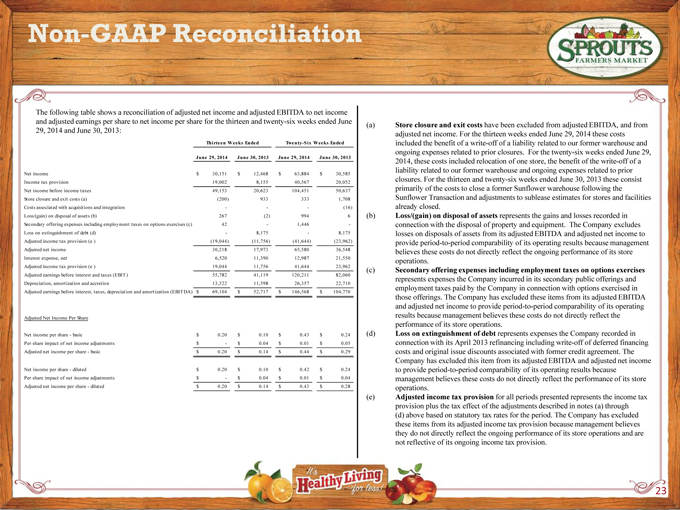
Non-GAAP Reconciliation
The following table shows a reconciliation of adjusted net income and adjusted EBITDA to net income and adjusted earnings per share to net income per share for the thirteen and twenty-six weeks ended June 29, 2014 and June 30, 2013:
Thirteen Weeks Ended Twenty-Six Weeks Ended
June 29, 2014 June 30, 2013 June 29, 2014 June 30, 2013
Net income $ 30,151 $ 12,468 $ 63,884 $ 30,585
Income tax provision 19,002 8,155 40,567 20,052
Net income before income taxes 49,153 20,623 104,451 50,637
Store closure and exit costs (a) (200) 933 333 1,708
Costs associated with acquisitions and integration — — — (16)
Loss/(gain) on disposal of assets (b) 267 (2) 994 6
Secondary offering expenses including employment taxes on options exercises (c) 42 — 1,446 -
Loss on extinguishment of debt (d) — 8,175 — 8,175
Adjusted income tax provision (e ) (19,044) (11,756) (41,644) (23,962)
Adjusted net income 30,218 17,973 65,580 36,548
Interest expense, net 6,520 11,390 12,987 21,550
Adjusted income tax provision (e ) 19,044 11,756 41,644 23,962
Adjusted earnings before interest and taxes (EBIT) 55,782 41,119 120,211 82,060
Depreciation, amortization and accretion 13,322 11,598 26,357 22,710
Adjusted earnings before interest, taxes, depreciation and amortization (EBITDA) $ 69,104 $ 52,717 $ 146,568 $ 104,770
Adjusted Net Income Per Share
Net income per share—basic $ 0.20 $ 0.10 $ 0.43 $ 0.24
Per share impact of net income adjustments $ — $ 0.04 $ 0.01 $ 0.05
Adjusted net income per share—basic $ 0.20 $ 0.14 $ 0.44 $ 0.29
Net income per share—diluted $ 0.20 $ 0.10 $ 0.42 $ 0.24
Per share impact of net income adjustments $ — $ 0.04 $ 0.01 $ 0.04
Adjusted net income per share—diluted $ 0.20 $ 0.14 $ 0.43 $ 0.28
(a) Store closure and exit costs have been excluded from adjusted EBITDA, and from adjusted net income. For the thirteen weeks ended June 29, 2014 these costs included the benefit of a write-off of a liability related to our former warehouse and ongoing expenses related to prior closures. For the twenty-six weeks ended June 29, 2014, these costs included relocation of one store, the benefit of the write-off of a liability related to our former warehouse and ongoing expenses related to prior closures. For the thirteen and twenty-six weeks ended June 30, 2013 these consist primarily of the costs to close a former Sunflower warehouse following the Sunflower Transaction and adjustments to sublease estimates for stores and facilities already closed.
(b) Loss/(gain) on disposal of assets represents the gains and losses recorded in connection with the disposal of property and equipment. The Company excludes losses on disposals of assets from its adjusted EBITDA and adjusted net income to provide period-to-period comparability of its operating results because management believes these costs do not directly reflect the ongoing performance of its store operations.
(c) Secondary offering expenses including employment taxes on options exercises represents expenses the Company incurred in its secondary public offerings and employment taxes paid by the Company in connection with options exercised in those offerings. The Company has excluded these items from its adjusted EBITDA and adjusted net income to provide period-to-period comparability of its operating results because management believes these costs do not directly reflect the performance of its store operations.
(d) Loss on extinguishment of debt represents expenses the Company recorded in connection with its April 2013 refinancing including write-off of deferred financing costs and original issue discounts associated with former credit agreement. The Company has excluded this item from its adjusted EBITDA and adjusted net income to provide period-to-period comparability of its operating results because management believes these costs do not directly reflect the performance of its store operations.
(e) Adjusted income tax provision for all periods presented represents the income tax provision plus the tax effect of the adjustments described in notes (a) through (d) above based on statutory tax rates for the period. The Company has excluded these items from its adjusted income tax provision because management believes they do not directly reflect the ongoing performance of its store operations and are not reflective of its ongoing income tax provision.
23

It’s Healthy Living
For less
























